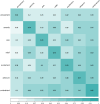The bright side of words: Norms for 9000 Spanish words in seven discrete positive emotions
- PMID: 37749425
- PMCID: PMC11289151
- DOI: 10.3758/s13428-023-02229-8
The bright side of words: Norms for 9000 Spanish words in seven discrete positive emotions
Abstract
In recent years, assumptions about the existence of a single construct of happiness that accounts for all positive emotions have been questioned. Instead, several discrete positive emotions with their own neurobiological and psychological mechanisms have been proposed. Of note, the effects of positive emotions on language processing are not yet properly understood. Here we provide a database for a large set of 9000 Spanish words scored by 3437 participants in the positive emotions of awe, contentment, amusement, excitement, serenity, relief, and pleasure. We also report significant correlations between discrete positive emotions and several affective (e.g., valence, arousal, happiness, negative discrete emotions) and lexico-semantic (e.g., frequency of use, familiarity, concreteness, age of acquisition) characteristics of words. Finally, we analyze differences between words conveying a single emotion ("pure" emotion words) and those denoting more than one emotion ("mixed" emotion words). This study will provide researchers a rich source of information to do research that contributes to expanding the current knowledge on the role of positive emotions in language. The norms are available at https://doi.org/10.6084/m9.figshare.21533571.v2.
Keywords: Amusement; Awe; Contentment; Emotional ratings; Excitement; Positive emotions; Relief and pleasure; Serenity.
© 2023. The Author(s).
Conflict of interest statement
The authors declare no competing interests.
Figures





References
-
- Aguado, L., Diéguez-Risco, T., Villalba-García, C., & Hinojosa, J. A. (2019). Double-checking emotions: Valence and emotion category in contextual integration of facial expressions of emotion. Biological Psychology,146, 107723. 10.1016/j.biopsycho.2019.107723 10.1016/j.biopsycho.2019.107723 - DOI - PubMed
-
- Alexander, R., Aragón, O. R., Bookwala, J., Cherbuin, N., Gatt, J. M., Kahrilas, I. J., ..., Styliadis, C. (2021). The neuroscience of positive emotions and affect: Implications for cultivating happiness and wellbeing. Neuroscience & Biobehavioral Reviews, 121, 220–249. 10.1016/j.neubiorev.2020.12.002 - PubMed
Publication types
MeSH terms
Grants and funding
LinkOut - more resources
Full Text Sources

